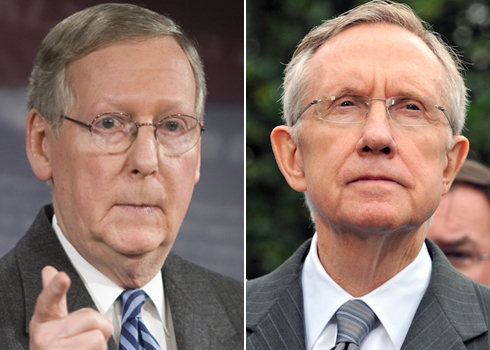A bit more information on the plan Senate Majority Leader Harry Reid (D-NV) and Senate Minority Leader Mitch McConnell (R-KY) are ironing out to raise the debt limit, and avoid a catastrophic debt default.
You’ll recall that McConnell’s original vision was heavy on the politics, but substantively amounted to allowing President Obama to raise the debt limit with no policy strings attached — no spending cuts, no tax increases, nada. The rub was that Obama would have to raise the debt ceiling in three increments, and notify Congress of his intent each time. Each time, Congress would vote, or attempt to vote, to stop him from doing so. Each time, he’d veto. Each veto would be sustained by a minority vote in both the House and Senate. In addition, each time, he’d have to draw up a menu of aspirational spending cuts of his choice, in the amount by which he’s raising the debt limit.
In an unexpected turn, Reid is proposing to give McConnell back the “clean,” no-strings-attached aspect of his offer, according to a highly-placed Democratic source.
“We want to see what cuts are agreed to [in the White House meetings] and pass those,” the source said. “That’s the attitude now.”
McConnell would have to give, too — possibly by relenting on the politics, which as currently envisioned would force Dems to take symbolic debt ceiling votes well into election year. But another option would be to take the cuts identified in the White House meetings — expected to be in the vicinity of $1.5 trillion — and split them up, so they could be attached to the three debt-limit votes.
“That way, they’re not voting to raise the debt limit, they’re voting for deficit reduction,” the source added.
A top GOP official cautioned that the details of the plan are still being negotiated, but noted that it will be anchored by legislation, currently being crafted, that effectively raises the debt limit, cuts spending, and, as previously reported, creates a bipartisan, bicameral commission (likely 12 members total) to craft a much bigger deficit reduction plan. That package, if agreed to, would be guaranteed votes in the House and Senate.
This could run into one problem: As long as cuts are on the table, Republicans have said they only want to raise the debt limit by the amount of money Congress cuts from the budget over the next decade. If they hold to that arbitrary standard, Democrats would still be several hundred billion dollars shy of the $2.4 trillion figure needed to raise the debt limit through 2012.
One outstanding question is whether setting up a Congressional deficit committee would be enough for Republicans to accept a lower overall spending cut total.










